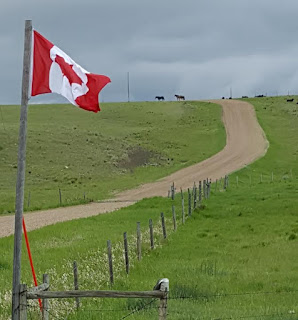Along the Red Coat Trail
Eastend, Saskatchewan
is about an hour as the crow flies from the Alberta border, an hour and a half
by car. So why is a town in the southwest corner of the province called
Eastend? As with so much around here, it
goes back to the RCMP. Eastend was the
eastern-most detachment for the Northwest Mounted Police HQ in Fort Walsh,
Alberta. The area was inhabited long before the RCMP arrived, but the redcoats
were better with paperwork, so Eastend it is.
This is cattle
country. And, with the discovery of a
T-Rex skeleton nearby, it’s now dinosaur country, too. (We’ll leave Scotty, who was discovered by a
high school principal walking along a cow trail, for another day.) The vast, ancient sea bed that’s permeated
with rich minerals conducive to agriculture is also larded with the bones of
wonderful creatures such as Mo, the sea-serpent who lived 75 million years ago
in nearby Ponteix. Mo is grinning
balefully from his perch alongside Highway 13 (our favourite road in
Saskatchewan, so far).
Mo, of the elasmosaurus
genus, was discovered in 1992 by a local high school student, Bob St. Cyr, who
is now a renowned photographer (that’s not him, above).
As distracting as the
dinosaurs are, we were in Eastend to attend a book reading by Vancouver writer
Beryl Young. Beryl’s newest book, Miles to Go, is based on a story from
her childhood about a family that gives up their baby when the mother dies in
childbirth. Beryl has mined her past in an earlier book about her dad, Charlie: A Home Child’s Life in Canada.
Her father, an RCMP officer who was wounded in the First World War, was sent to
Canada from England as a Barnardo boy. These are richly told, little-known
stories from our recent past. Beryl
encourages everyone to give voice to their family histories – it’s our literary
DNA that we share with the future.
The little town of
Eastend is a massive trove of Canadian stories.
Wallace Stegner, the Pulitzer and National Book Award prizewinner, spent
his childhood in Eastend, which he called Whitemud in his memoir, Wolf Willow. Get your hands on this book and read it if
you have any curiosity about the Canadian west.
The Stegner family home is now a sponsored retreat for visiting writers (Beryl
was one of them).
The idea for the
retreat was driven by Sharon Butala, who worked as a writer and rancher’s wife in
Eastend for more than ten years. Her
fiction and the splendid The Perfection
of the Morning are Canadian bestsellers that capture the birdsong, the
fragrance and the cadence of small town Saskatchewan life. Dianne Warren’s gorgeous first novel, Cool Water, is set in the fictitious
town of Juliet, Saskatchewan. A stand-in
for Eastend?
On the road back home we
pass by the town of Aneroid. Something
to do with barometric pressure, my intelligent husband asks? Pretty close. The town was named by a surveyor who lost his equipment on that
site. It’s probably still around here somewhere.
With the setting sun
throwing astonishing light effects across the sky (sundog rainbows?) we stop to
listen to the geese ravelling into formation overhead. We’ve seen tens of thousands of snow geese
this month and are compelled to invent a new collective noun. Paul suggests a google of geese. A google is a 1 followed by 100 zeroes. So how many gaggles in a google? Any
thoughts? Talk to you later.








Marion the Librarian here....Dianne Warrens book is called Cool Water, not Cool River. I know because my bookclub in Mexico read it!
ReplyDelete